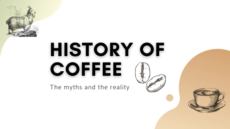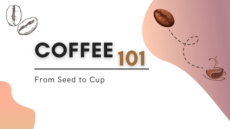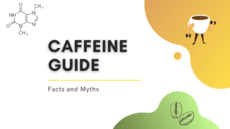There is not that much thought that goes into drinking your cup of Joe in the morning before you get to work, is there? Pretty much, that is what you need to get through the day, but truly, there is much more to coffee then just what you sip in your latte. Firstly, that vital caffeine content within your coffee is found in the endosperm of the coffee seed at .8 to 2.5%. This is responsible for waking you up and getting you through the day.
Moving on, the coffee plant itself has the capability of producing the equivalent of 1 pound of freshly roasted coffee. That is a lot of work for one little plant! During the roasting process, the beans will crack and excrete essential oils, which are responsible for the deep taste of your Java. Make sure that you never put your coffee beans in the freezer because that will dehydrate them and affect the flavor through the loss of the essential oils.
Brief History Of Coffee
Coffee has a long and fascinating history that stretches across continents and centuries. Coffee’s origins can be traced back to ancient Ethiopia, where a goat herder named Kaldi is said to have discovered the energizing effects of the coffee plant after noticing his goats becoming unusually active after eating the plant’s berries. Coffee spread from Ethiopia to neighboring countries like Yemen, where it was first cultivated for commercial use in the 15th century. Coffee arrived in Europe in the 16th century and quickly became popular as a beverage. Coffee was introduced to America in the 18th century, and by the 19th century, it had become a household staple as well as a major commodity in international trade. Read our full coffee history article if you are interested to know more.
Today, coffee is the most popular beverage in the world, consumed by millions of people every day. It is grown in many countries across the globe, and continues to play an important role in culture, economy, and society.
Main Coffee Brewing Methods
When it comes to your coffee brewing choices, there are about four when you break them up into categories. Make your decision based on your needs and which method will work best for your daily life!
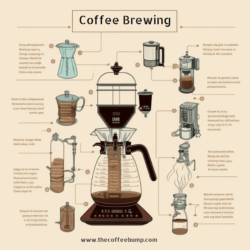
Boiling Method
This method of brewing coffee involves boiling ground coffee in water. This is the simplest and most traditional way of brewing coffee, and it is still used in some cultures today. The coffee is usually brewed in a pot or kettle and left to boil for a few minutes before being served. However, the boiling method can lead to a bitter taste due to over-extraction.
Steeping Method
This method of brewing coffee involves steeping ground coffee in hot water. The French press and the Cold brew are examples of this method. The coffee is placed in a container with a filter, and hot water is poured over it. The coffee is then left to steep for a certain period of time before the filter is pressed or the coffee is separated from the liquid. This method can produce a smooth and rich taste, but it can also lead to over-extraction if left to steep for too long.
Dripping Method
This method of brewing coffee involves dripping hot water over ground coffee. The drip coffee and pour over methods are examples of this method. The coffee is placed in a filter, and hot water is poured over it. The coffee is then allowed to drip through the filter and into a carafe. This method can produce a clean and balanced taste, but it requires precise control over the water temperature and flow rate.
Pressure Method
This method of brewing coffee involves using pressure to force hot water through ground coffee. The Espresso is the most well-known example of this method. The coffee is placed in a portafilter and hot water is forced through it under high pressure. This method can produce a strong and flavorful taste, but it requires specialized equipment and a high level of skill to achieve the desired results.
Each method has its advantages and disadvantages, and the resulting taste and strength of the coffee depends on the brewing time, water temperature, and the grind size. The most popular method vary from country to country, culture to culture, and personal preferences.
Coffee Brewing Methods in details
One of the most significant distinctions in coffee brewing methods is the degree of control they provide over the final flavor of the coffee. Some methods, such as the French press, give you a lot of control over the intensity and flavor of your coffee, but others, such as the drip brew, give you less control and produce a gentler, cleaner cup of coffee. Furthermore, some methods, like as espresso, are known for their powerful and concentrated taste, whereas others, such as vacuum coffee or syphon, are known for their clean and complex taste. Understanding these distinctions can assist you in making an informed decision about which strategy to employ and how to adjust the parameters to achieve the desired outcomes.
Traditional Drip Brew Coffee
This is something you may be more familiar with because you can find these in almost every home.
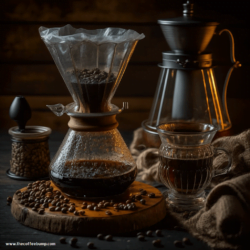
Traditional drip brew coffee is a method of brewing coffee in which hot water is poured over ground coffee beans trapped in a filter. Hot water removes the flavors and caffeine from the coffee beans, resulting in a cup of coffee. The conventional drip brew method, often known as “filter coffee” or “drip coffee,” is one of the most popular and easiest brewing methods.
Making classic drip brew coffee typically entails the following steps:
- Heat the water to the appropriate temperature (about 195-205°F).
- Fill the coffee maker with a filter and ground coffee.
- Pour the hot water over the coffee grinds slowly, making sure to evenly saturate them.
- Wait for the coffee to brew; this usually takes around 3-5 minutes.
- Once the brewing process is complete, the coffee will drip into the carafe or pot.
- Serve and enjoy.
There are several machines that use the drip brew method to make coffee, some of the most popular ones are:
- Automatic Drip Coffee Maker: This is the most common type of drip brew machine, it has a built-in water reservoir, heating element and a brewing system. It is easy to use, and you can program it to start brewing at a specific time.
- Pour-over Coffee Dripper: This method uses a pour-over cone or a V60 dripper which holds the coffee filter and ground coffee, placed on top of a carafe or a mug. The user pour hot water manually over the coffee grounds to brew the coffee.
This will offer you time saved and convenience because you can often program them to brew 24 hours in advance. The only catch is the use of paper filters which will affect the taste of the coffee because there will be no essential oils in the final brew.
French Press
The French press, also known as a cafetière or coffee press, is a simple and traditional technique of brewing coffee in which the grounds are steeped in hot water and then separated from the liquid using a metal mesh plunger.
Making coffee with a French press normally entails the following steps:
- Heat the water to the appropriate temperature (about 200°F).
- Place the French press on a sturdy surface and fill the carafe with coarsely ground coffee.
- Pour the hot water over the coffee grinds slowly, making sure to evenly saturate them.
- Allow the coffee to steep for 4 minutes.
- To separate the coffee grounds from the liquid, slowly press the plunger down to the bottom of the carafe.
- Pour the freshly made coffee into a cup and enjoy.
This is the preferred coffee brewing method because it does not use a paper filter, but you instead plunge the grounds down that are being steeped in hot water. This will give a more bold taste to your brew because the essential oils remain in the final brew product.
Stovetop Coffee Maker (Moka pot)
These brewers are sometimes called Moka pots, and they have two chambers, which you can heat on your stovetop. The bottom chamber will have cold water and the coffee grounds, and when it is heated, it will push to the top chamber for the final brew product. Again, a great taste because paper filters are not used.
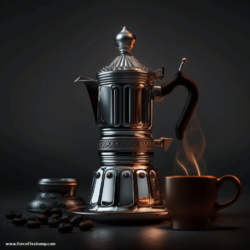
Stovetop espresso makers are more popular than ever because they provide an easy alternative to a larger home espresso machine. They are also a cheaper option, and they will allow you to brew espresso directly on your stove in moments. Here are some easy tips to help you on your way:
- Start out by adding fresh water to the bottom chamber of the pot. Do not fill above the safety valve.
- Use a fine espresso grind, and pack the filter basket loosely. If you pack too tight, the espresso will not extract properly.
- Place the filter basket into the bottom chamber, and screw the top chamber on. Make sure that the device is sealed well.
- Place the stovetop espresso maker on your stove on medium heat until you hear the espresso beginning to brew. Lower the heat at this time for a few moments, and then turn off the heat completely.
And there you have it – delicious stovetop espresso in moments!
Vacuum Coffee Makers (Siphon)
Vacuum technique also known as siphon or syphon brewing. This type of brewing uses a vacuum method, where two chambers made of glass are placed on top of each other. The lower chamber will hold the water, which will start to boil. The vacuum mechanism will then pull the boiling water up to the top chamber through the coffee grounds to extract for the final brew product. A delicious taste because no paper filters are used!
The process of making coffee using a vacuum method typically involves the following steps:
- Fill the lower chamber with cold water and place it on a heat source.
- Heat the lower chamber to create steam.
- Once the steam has forced the water into the upper chamber, add ground coffee to the upper chamber.
- Stir the coffee grounds to ensure even saturation.
- Allow the coffee to brew for several minutes, typically 3-5 minutes.
- Once the brewing process is complete, remove the heat source to create a vacuum, which forces the cursed coffee back into the lower chamber.
- Pour the coffee into a cup and enjoy.
Espresso
Espresso is a method of brewing coffee that uses high pressure to drive hot water through finely ground coffee beans, resulting in a concentrated, powerful coffee. Making espresso traditionally involves using an espresso machine, which normally consists of a water tank, a heating element, a pump, a group head, and a portafilter.
The process of making espresso using an espresso machine typically involves the following steps:
- Fill the water tank with fresh, cold water.
- Turn on the machine and allow it to heat up.
- Grind the coffee beans to the right grind size for espresso.
- Place the ground coffee into the portafilter, tamp it down to ensure an even extraction.
- Place the portafilter into the group head and lock it in place.
- Start the pump and allow the hot water to pass through the coffee grounds, this process is called extraction.
- Once the extraction is complete, usually 25-30 seconds, you should have around 1-1.5 oz of concentrated coffee in the cup.
- Pour the coffee into a demitasse cup and enjoy.
While traditional espresso is a simple and concentrated cup of coffee, it can be used as a base to create a variety of delicious and popular coffee drinks. From the classic Americano to the creamy and frothy Cappuccino, each espresso-based drink offers a unique flavor and experience.
here are brief explanations of some popular espresso-based drinks:
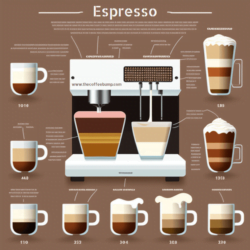
- Americano: A simple and classic espresso drink, it is made by adding hot water to a shot of espresso, resulting in a longer and milder cup of coffee.
- Cappuccino: A popular espresso-based drink, it is made with a shot of espresso, steamed milk and a layer of foam on top. It is usually served in a smaller cup and has a stronger coffee flavor than a latte.
- Latte: A popular espresso-based drink, it is made with a shot of espresso, steamed milk and a small amount of foam on top. It is usually served in a larger cup and has a milder coffee flavor than a cappuccino.
- Macchiato: A simple espresso-based drink, it is made with a shot of espresso and a small amount of foamed milk on top. It is usually served in a smaller cup and has a stronger coffee flavor than a latte or cappuccino.
- Flat White: A popular espresso-based drink, it is made with a shot of espresso and a small amount of steamed milk. It is usually served in a smaller cup and has a stronger coffee flavor than a latte, but less foam than a cappuccino.
- Mocha: A popular espresso-based drink, it is made with a shot of espresso, steamed milk, chocolate, and sometimes whipped cream on top. It has a rich and creamy chocolate flavor.
These are some of the most popular espresso-based drinks, but there are many other varieties that you can explore. Keep in mind that the final taste of each drink may vary depending on the recipe and the ingredients used.
Also if you’re wondering the big difference between an espresso bean and a coffee bean, then most of the time it is specific to the roaster that it came from. Espresso roasts are much darker, like a Vienna or a French roast, and they do use a variety of coffee beans to achieve that. Many roasters do not like to divulge their espresso roast secrets, but you can count on them being much richer and fuller for the premium use of espresso.
Cortado Coffee
Cortado coffee is a traditional beverage that is often found in Portugal, Spain, and Latin America. The word cortado means shortened in Spanish, so you can expect a shortened version of an espresso drink with this brew.
To make cortado coffee, start out by brewing a fresh shot of espresso, and then steaming milk on your home espresso machine. Add a small amount of steamed milk without foam to the espresso to complete the drink, which should overall range from 5 to 7 ounces.
This is a smaller version of a regular espresso beverage, and it also makes it easier for you to taste the richness of the espresso itself. This drink has many different versions, so you may be able to find it made with condensed milk or even a dash of cream!
Turkish Coffee

This is a global coffee flavor that you must try, and it is surprisingly easy to make Turkish coffee! You will need a small Turkish coffee pot that has a handle that you can hold over your stove.
- Begin by adding water to the Turkish coffee pot.
- You will then add very finely ground coffee, even finer than an espresso grind.
- Add these fresh grounds to your water, and heat over your stove on medium heat, stirring well until it comes to a boil.
- Serve immediately in small Turkish coffee cups that hold about 2 ounces. The grounds will sink to the bottom of the cup.
- After the grounds have sunk to the bottom of the cup, you can drink the delicious brew, but don’t drink the coffee grounds sitting in the bottom!
The coffee grounds that remain in the bottom of your cup after drinking were often traditionally used to tell your fortune by flipping over your cup to see what pattern it makes. Either way, I can tell that a delicious cup of Turkish coffee is in your future!
Irish Coffee
In the spirit of the recently passed St. Patrick’s Day, here is a detailed history of delicious Irish coffee.
The basics are that Irish coffee is a cocktail made from sugar, Irish whiskey, and coffee, topped with whipped cream. In the original recipe, the cream is actually not whipped, but it is a thick and heavy cream on top of the brew. Irish coffee was invented by Joseph Sheridan, who was a head chef at a restaurant in the West of Ireland. The coffee was created after a group of American tourists came into the establishment on a cold winter night in the 1940s, where the chef added whiskey to their coffee to help warm them up. He called it Irish coffee, and the reputation grew from there.
Irish coffee was introduced to the United States in the 1950s, where a travel writer gave mention of it in the San Francisco Chronicle.
From there, the Irish method was created to float cream on top of the cup of Joe as a rich and heavy treat. It was also recommended for the cream to be aged for up to 48 hours before its use so that it could float more easily on the brew.
Concocting an Irish coffee yourself is quite simple, and you can start with black coffee in a specialty mug. Mix in 1 teaspoon of sugar and a shot of whiskey, and pour heavy cream over the back of a spoon over the top of the coffee. This will create a delicious layer of cream on top for you to enjoy!
Instant Coffee
What Processes Are Used To Make Instant Coffee?
As a coffee lover, you do not necessarily need to turn your nose up at an instant cup of Joe, you just need to know which process to look for to make sure that all of the flavors are still there when you create your instant coffee product.
There are two processes used to make instant coffee, freeze drying and spray drying. Freeze drying is the preferred method because the coffee product is left out so that all of the water naturally evaporates, leaving a coffee concentrate. This concentrate is then frozen, and the ice is taken out of the freeze dried coffee crystals in a process called sublimation. This allows the essential oils to remain in the freeze dried coffee crystals so that your instant cup of Joe is as delicious as ever.
Spray drying also does allow water to evaporate so that a coffee concentrate is formed again, and then this concentrate is placed in a hot air chamber so that the water is evaporated at a high temperature. This leaves coffee crystals at the bottom of the chamber, but the essential oils are zapped from the product because of the high heat that is used.
Keep these facts in mind when looking for premium instant coffee to give you some added convenience during travel, camping, or even baking!
Cold Brewed Coffee
The Best Method For Cold Brewed Coffee
If you are someone who has a hard time stomaching the acidity in your cup of Joe, so to speak, then you may want to consider a Toddy Maker to cold brew your coffee with. A Toddy Maker is a coffee maker to cold brew your coffee in, which can produce up to 67% less acidity in the final brew product.
The only disadvantage to cold brewing coffee is that it will take some time, and you do need to store it in your refrigerator overnight. However, this is the preferred method for many people who have stomach issues and want a cup of Joe with less oil and acidity. The Toddy Maker provides a smoother and milder brew product, and you can have cold coffee on hand to create iced coffees at any time. You also have the option of adding hot water directly to the coffee concentrate to make a hot cup of Joe as well.
This is a fun alternate method to try in your coffee brewing, especially if you do have stomach issues with the acidity found in coffee. I am always up for a cup of Joe anytime, whether it be cold or hot!
Ice Coffee
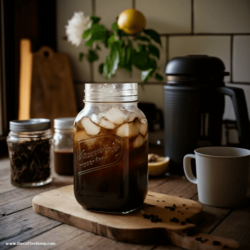
How To Make The Best Iced Coffee?
Knowing how to make an expert iced coffee is a must if you want to be a coffee lover all year round. Read on for some easy tips and the best ways to make a delicious iced coffee that will keep you cool on a hot summer day!
- First of all, make sure that you freeze coffee ice cubes in advance in an ice cube tray in your freezer. This is absolutely the only way to make an iced coffee because these coffee ice cubes will not water down your drink as they melt.
- Next, get creative and use a variety of flavored syrups or liquors to sweeten up your drink and give it a little kick. Personally, I recommend using either Bailey’s, Kahlúa, or Amaretto to add a nice little pop to your drink.
- Lastly, try a different variety of summer coffee drinks by first blending your coffee ice cubes in a blender before you add them to your drink. This is a simple tip, and it will give a great slushy quality to your drink as a result, making it even more delicious.
This is the best way to enjoy your Java in these hot summer months!
Factors affecting the taste of coffee
Several factors can influence the taste of coffee, including:
Bean Freshness and Quality: The quality and freshness of the coffee beans are critical for a great cup of coffee. Freshly roasted beans are more complex and flavorful than older beans. The origin of the beans, varietals, and processing method all influence the flavor of the coffee.
Grind Size and Consistency: The grind size and consistency of the coffee beans can have a significant impact on the flavor of the coffee. A fine grind will extract more flavor and caffeine than a coarse grind, but over-extraction will result in a bitter taste. Grind size consistency is important because uneven grinds can lead to inconsistent extraction and a less balanced cup of coffee.
Water Quality: The quality of the water used to brew coffee can have a significant impact on the taste of the coffee. Coffee can taste metallic or bitter if it is made with hard water or water with a high mineral content. Filtered or purified water can help to remove impurities and improve coffee flavor.
Brewing Temperature: The temperature at which the coffee is brewed and brewed can have an impact on the flavor of the coffee. Over-extraction and a bitter taste can result from using too hot water, while under-extraction and a weak taste can result from using too cold water. The ideal brewing temperature ranges from 195 to 205°F.
Brewing Time: The brewing time has an impact on the flavor of the coffee. Over-brewing can result in a bitter flavor, while under-brewing can result in a weak flavor. The ideal brewing time varies depending on the method used, but it should always be sufficient to extract the desired flavors.
Altitude: The altitude at which the coffee is grown can have an impact on the taste of the coffee. The slower the coffee cherries ripen at higher altitudes, the denser the bean, with more complex flavors and higher acidity.
Understanding these factors and how they affect coffee flavor allows you to make changes to your brewing methods and ingredients to achieve the perfect cup of coffee.
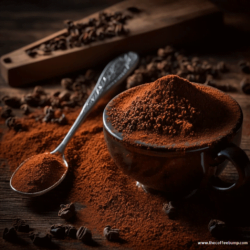
Conclusion
Summary of the different coffee making techniques
Here’s a summary of the most well-known coffee brewing methods.
Espresso: A method of brewing coffee in which hot water is forced under high pressure through finely ground coffee.
Drip Brewing: A method of brewing coffee in which hot water is poured over coffee grounds and allowed to drip into a carafe through a filter.
French Press: A coffee brewing method in which coarsely ground coffee is steeped in hot water before being separated from the liquid by pressing a plunger through a mesh filter.
Pour Over: A coffee brewing method in which hot water is poured over coffee grounds in a filter, allowing the coffee to drip into a carafe.
Siphon Brewing: A method of brewing coffee in which vapor pressure and vacuum are used.
Cold Brew: A method of brewing coffee in which the coffee is steeped for an extended period of time, usually 12-24 hours, in cold or room temperature water.
Turkish Coffee: A method of brewing coffee in which finely ground coffee is mixed with hot water and brought to a boil before serving.
Moka Pot: A coffee brewing method in which water is boiled in the bottom chamber and forced upward through a filter and coffee grounds in the middle chamber, then through a spout and into the top chamber, where it is ready to serve.
Aeropress: A coffee brewing method that uses air pressure to force water through coffee grounds, producing a rich, smooth cup of coffee.
Importance of experimenting with different methods to find personal preference
Experimenting with different methods of making coffee is an important step in finding your personal preference. Each method has its own unique characteristics and produces a different flavor profile, which can vary greatly from one method to another.
For example, coffee made with a French press tends to have a stronger and bolder flavor, while coffee made with a drip brew method tends to be milder and cleaner. Similarly, coffee made with a Moka pot has a stronger and full-bodied flavor compared to coffee made with an aeropress which is smoother and milder. The same applies to the different variations of espresso-based drinks.
By experimenting with different methods of making coffee, you can discover the flavors and characteristics that you prefer and find the method that best suits your taste. It’s important to keep in mind that the quality of the beans, the grind size, the water temperature, the brewing time, and the proportions of coffee and water used, also play a crucial role in the final taste of the coffee.
Additionally, experimenting with different methods of making coffee can also be a fun and rewarding experience. It allows you to learn more about the coffee brewing process and the science behind it, which can make you appreciate the art of making coffee even more. Moreover, it can also inspire you to try new recipes and create your own unique blends.
FAQ
How do I make sure I am using the right grind size for my brewing method?
The grind size is crucial for the brewing method, a fine grind is suitable for espresso and Turkish methods, a medium grind for French press, pour-over, and drip, and a coarse grind for cold brew and Sous-vide. Using the wrong grind size can lead to over-extraction, under-extraction, or a weak or bitter taste.
Each brewing method has a recommended grind size, it’s a good idea to use a burr grinder to achieve a consistent grind size.
How do I adjust the brew strength and taste to my preference?
There are several ways to adjust the brew strength and taste to your preference:
For a stronger brew, you can use more coffee grounds or increase the brewing time.
For a milder brew, you can use less coffee grounds or decrease the brewing time.
For a sweeter taste, you can use high-quality, freshly roasted beans or adjust the water temperature.
For a more acidic taste, you can use beans that are grown at high altitude or a lighter roast.
Experimenting with different brewing methods and adjusting the water temperature, brew time, and the amount of coffee can help you achieve the perfect brew strength and taste for your preference.
It’s important to keep in mind that the taste of coffee can be affected by other factors as well, such as the quality and freshness of the beans, the water quality, and the brewing equipment.
How to make a perfect cup of coffee with the brewing method I choose?
To make a perfect cup of coffee with your chosen brewing method, you need to use high-quality, freshly roasted beans, clean and appropriate equipment, and the right grind size.
It’s also important to pay attention to the water temperature, brewing time, and the ratio of coffee to water. Experimenting with different brewing parameters and adjusting them to your preference can help you achieve a perfect cup of coffee.
How do I clean and maintain my coffee brewing equipment?
Cleaning and maintaining your coffee brewing equipment is crucial to ensure a consistent and high-quality cup of coffee. Here are a few tips for cleaning and maintaining different types of coffee brewing equipment:
Espresso machines: Clean the portafilter, group head, and filters regularly. Backflush the machine with cleaning solution and run a cleaning cycle.
French press: Disassemble the press and wash all parts with warm soapy water. Rinse thoroughly and dry.
Pour-over: Clean the filter and the pour-over device regularly. Rinse thoroughly and dry.
Cold brew: Clean the container and the filter thoroughly after each use.
Siphon/vacuum: Disassemble the siphon and wash all parts with warm soapy water. Rinse thoroughly and dry.
Turkish: Clean the cezve with warm soapy water and dry thoroughly.
Aeropress: Disassemble the Aeropress and wash all parts with warm soapy water. Rinse thoroughly and dry.
Moka pot: Disassemble the Moka pot and wash all parts with warm soapy water. Rinse thoroughly and dry.
Sous-vide: Clean the container and the bag thoroughly after each use.
Regular cleaning and maintenance will help prolong the life of your equipment and ensure that you are getting the best quality cup of coffee.
How do I brew coffee in large quantities?
Brewing coffee in large quantities requires a bit of planning and the right equipment. Here are a few tips:
Use a large coffee maker or a commercial-grade coffee brewing system.
Use the right amount of coffee grounds and water to achieve the desired strength and taste.
Use a thermometer to ensure the water is at the right temperature.
Use a timer to ensure the brewing process is consistent and accurate.
Use a pitcher or carafe to keep the brewed coffee warm and ready to serve.
Clean and maintain the equipment regularly to ensure a consistent and high-quality cup of coffee.
What are the benefits of using a specific brewing method?
Each brewing method has its own unique benefits and drawbacks. Here are a few examples:
Espresso: Produces a strong, concentrated coffee with a rich, full-bodied taste.
French press: Produces a smooth, rich coffee with a full-bodied taste.
Pour-over: Produces a clean, balanced coffee with a mild
Cold brew: Produces a smooth, low-acidic coffee that can be served hot or cold.
Siphon/vacuum: Produces a clean, complex coffee with a balanced taste.
Turkish: Produces a strong, flavorful coffee with a rich aroma.
Aeropress: Produces a rich, smooth coffee with a milder taste.
Moka pot: Produces a strong, full-bodied coffee with a rich aroma.
Sous-vide: Produces a smooth, consistent coffee with a balanced taste.
Each brewing method has its own unique flavor profile, it’s a good idea to experiment and try different methods to find which one you like the most.
What are the different coffee brewing methods?
There are several coffee brewing methods including: Espresso, Drip Brewing, French Press, Pour Over, Siphon Brewing, Cold Brew, Turkish Coffee, Moka Pot, Aeropress, and Sous-vide.
How does the brewing method affect the taste of coffee?
The brewing method can affect the taste of coffee by controlling the extraction of flavor and caffeine from the beans. Different methods extract flavors in different ways and at different rates, which can affect the strength, aroma, and taste of the coffee.
What is the best coffee brewing method?
The best coffee brewing method depends on personal preference. Some people prefer the strong and bold taste of espresso, while others prefer the smooth and rich taste of French press or the clean and balanced taste of pour-over. Experimenting with different methods is the best way to find what you like.
How do I brew coffee using a French press?
To brew coffee using a French press, you will need coarsely ground coffee, a French press, and hot water. Place the coffee in the French press, pour hot water over it, and let it steep for 4 minutes. Then press the plunger down to separate the coffee from the liquid and serve.
How do I brew coffee using a pour-over method?
To brew coffee using a pour-over method, you will need a pour-over device, a coffee filter, and ground coffee. Place the coffee filter in the pour-over device, add the ground coffee, and pour hot water over it. Wait for the coffee to drip through the filter and into a carafe.
How do I brew coffee using a cold brew method?
To brew coffee using a cold brew method, you will need coarsely ground coffee, cold or room temperature water, and a container with a lid. Mix the coffee and water together in the container, and let it steep for 12-24 hours in the fridge. Then strain the coffee from the liquid and serve.
How do I brew coffee using an espresso machine?
To brew coffee using an espresso machine, you will need finely ground coffee, an espresso machine, and hot water. Place the coffee in the portafilter, tamp it down and lock it in the machine. Turn on the machine, and let the hot water force through the coffee under high pressure.
What is the difference between French press and pour-over coffee?
The main difference between French press and pour-over coffee is the way they are brewed and filtered. French press uses a metal mesh plunger to press the coffee grounds and keep them in the liquid while pour-over uses a paper or cloth filter that lets the coffee grounds and the brewed coffee are separated. French press coffee tends to be stronger, bolder and with more sediment, while pour-over coffee tends to be cleaner, clearer and with a milder taste.
How do I brew coffee using a siphon/vacuum method?
To brew coffee using a siphon/vacuum method, you will need a siphon brewer, ground coffee, and hot water. Fill the bottom chamber of the siphon brewer with hot water, place the ground coffee in the middle chamber, and place the top chamber on top.
As the water in the bottom chamber heats up, it creates vapor pressure that forces the water through the coffee grounds in the middle chamber, where it is infused with flavor. Once the brewing process is complete, the coffee is filtered back into the bottom chamber where it can be served.
How do I brew coffee using a Turkish method?
To brew coffee using a Turkish method, you will need finely ground coffee, a cezve (a small pot with a long handle), and water. Add the coffee and water to the cezve, place it on the stove over medium heat, and bring it to a boil. Once it reaches a boil, remove it from the heat and let it sit for a few minutes before serving.
How do I brew coffee using an Aeropress?
To brew coffee using an Aeropress, you will need ground coffee, an Aeropress, and hot water. Place the Aeropress on top of a mug, add the ground coffee, and pour hot water over it. Stir the coffee and water, and then press the plunger down to push the coffee through the filter and into the mug. The Aeropress uses air pressure to extract the flavors and produce a rich, smooth cup of coffee.
How do I brew coffee using a Moka pot?
To brew coffee using a Moka pot, you will need ground coffee, a Moka pot, and water. Fill the bottom chamber of the Moka pot with water, place the ground coffee in the middle chamber, and screw the top chamber on top. Place the Moka pot on a stove over medium heat, and wait for the water in the bottom chamber to boil and force its way through the coffee grounds in the middle chamber, and into the top chamber where it is ready to serve.
How do I brew coffee using a Sous-vide method?
To brew coffee using a Sous-vide method, you will need ground coffee, a Sous-vide machine, and hot water. Place the ground coffee in a bag and seal it. Then place the bag in a water bath and set the temperature on the Sous-vide machine to between 185-195°F. Leave it to brew for 2-4 hours depending on how strong you like your coffee. Once the brewing process is complete, remove the coffee bag, and enjoy your coffee.

